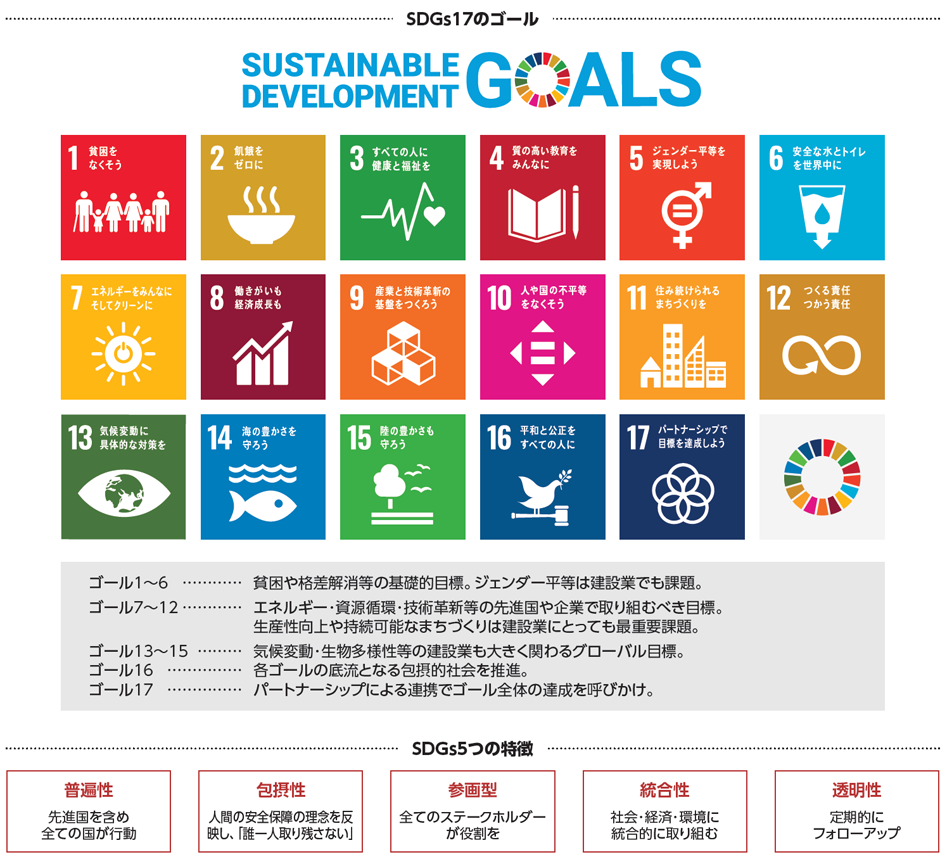Materiality and SDGs
As an “integrated engineering firm for urban creation,” Takenaka Corporation has identified major objectives (materiality) to resolve social issues and realize a sustainable society. We have incorporated these major objectives into our growth strategy, and we are deploying business activities by setting specific action plans and targets to achieve them.
1. Reviewing conventional major objectives in response to changes in the social environment
On this occasion, we reassessed social and environmental issues from short-, medium-, and long-term perspectives in the framework of business planning and target setting for the most recent three years, and we reviewed our major objectives (materiality) to list up priority activities that we should address. This is based on the idea of accurately grasping the rapidly changing corporate environment, adapting more flexibly, and steadily progressing toward where we would like to be. We have also held a series of dialogs with experts in order to place greater emphasis on external perspectives, and we have expanded the number of participating departments within the company from 10 to 17. Major objectives were identified with the aim of broadly and accurately recognizing changes in the corporate environment and social trends related to sustainability. As we work to address these major objectives, we are striving to create corporate value by realizing a sustainable society and our group vision through the resolution of social issues.

2. Reorganization into five categories with emphasis on social and environmental impact
In regard to our major objectives (materiality), we conducted an impact assessment of social issues that we had examined in 2020, and we proceeded to study these based on international guidelines and trends in the corporate environment. While paying attention to the traditions we have cultivated throughout our history and the characteristics of our corporate culture, moreover, we have divided our major objectives into the following five categories, and set KPIs and targets unique to our group with the aim of resolving social issues and achieving sustainable growth for our group. In addition to working on “sustainable architecture and urban creation” in these five categories, “harmony with the environment” requires efforts to achieve various global goals and to consider local characteristics within Japan, and “work style and productivity reform” requires the realization of diverse thinking and ideas. While building on improvements and reform in “steady production processes,” we must also incorporate the perspectives associated with global economic activities in the area of “respect for human rights.”

3. Indicators and targets for major objectives (materiality)

4. Relationship between our major objectives and SDGs
The major objectives that we have identified have been divided into five categories based on their relationship to our business activities. In parallel with the identification and evaluation of social issues, moreover, we also linked each objective to our SDGs and summarized them in the format shown in the table above. We established KPIs and target values in an attempt to measure progress and achievement in resolving issues, and we are implementing an action plan. Then, bearing in mind “how to proceed with our activities so that they can contribute to the realization of a sustainable society and the achievement of our SDGs,” we are engaging in “sustainable architecture and urban creation” while valuing “harmony with the environment,” promoting “work style and productivity reform,” and observing “respect for human rights” through “steady production processes.”
5. What are Sustainable Development Goals (SDGs)?
Adopted unanimously at the 2015 United Nations Summit, the goals that the world should aim for by 2030 are comprised of 17 goals and 169 targets under them. These cannot be achieved by the United Nations or national governments alone, so corporate participation is essential to resolve the social issues underlying these goals.

